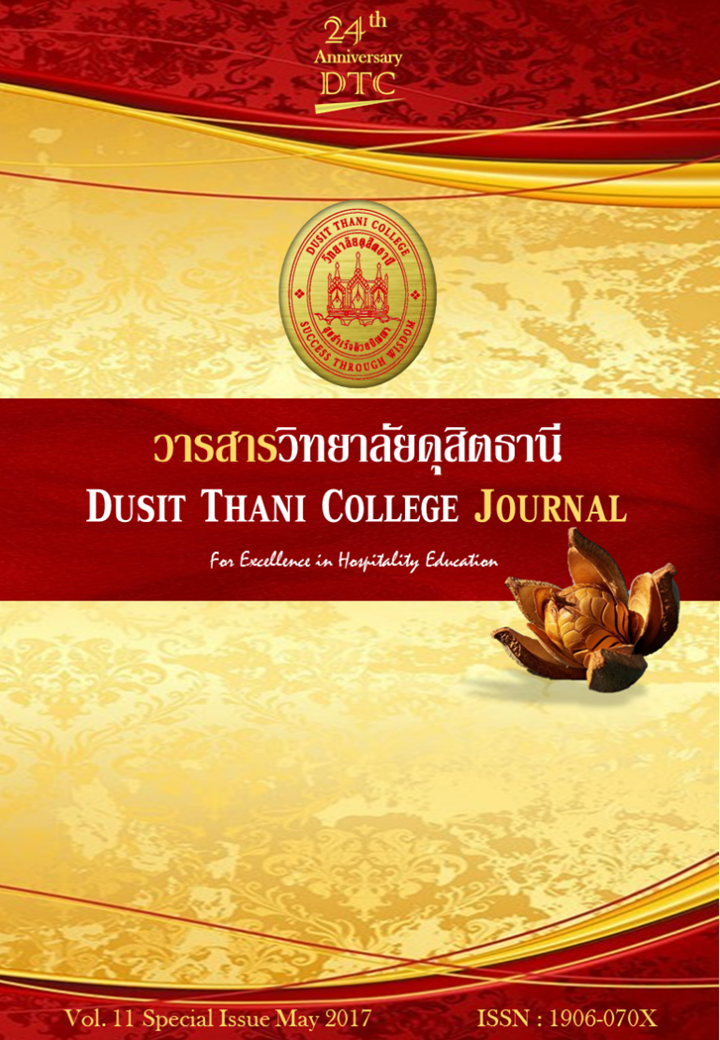Effectiveness Assessment of Vital Sport Tourism Marketing Factors in Buriram
Main Article Content
Abstract
The purpose of this research was to study key success factors and assessment the effectiveness levels of vital sport tourism marketing factors. In order to implement guidelines for prioritized approach to sport tourism development in Buriram. A questionnaire was used as data collection equipment. Survey questionnaires were collected from 400 Thai tourists who had travel experience in Buriram. The data were then analyzed with statistical analysis through descriptive statistics.
The results indicated that the main weakness issue of tourism in Buriram that we urgently need to adjust on is product, partnership and public opinion. Beside this investigation, the secondary issue that we should focus on and Buriram’s tourism can make the improvement is price, promotion and packaging.
Article Details
Article Screening Policy
- All research and academic articles to be published must be considered and screened by three peer reviews in the relevant field / article.
- All articles, texts, illustrations and tables published in the journal are the personal opinions of the authors. Editors don't always have to agree. And no responsibility whatsoever is the sole responsibility of the author.
- The articles to be published must never be published. Where did you first publish? And not in the consideration of other journals If the audit found that there has been a duplicate publication It is the sole responsibility of the author.
- Any article that the reader sees as being plagiarized or impersonated without reference. Or mislead the work of the author Please let the journal editor know it will be your greatest blessing.
References
Volume XV. 2(28).
Booms, B. H. and Bitner, M. J. (1981). Marketing Strategies and Organisation Structures for
Service Firms. In Marketing of Services. James H. D. and William R. G. (eds.).
Chicago, IL: American Marketing Association. Pp. 47-51.
Buriramguru. (2014). Discourse “Buriram City Sport World" by Newin Chidchop. Retrieved
January 14, 2017 from https://www.buriramguru.com
Chang International Circuit. (2014). Chang International Circuit : The phenomenon of
modern motorsport, Thailand. Retrieved January 14, 2017 from
https://www.bric.co.th/home/viewevent.aspx?id=508
Choibamroong, Therdchai. (2011). The Role of Local Governments on Sustainable
Tourism Development Based on the Concept of Sufficiency Economy Skills.
Bangkok: Cabinet and gazette Press.
Chu, R. K. S. and Choi, T. (2000). An Importance-Performance Analysis of Hotel Selection
Factors in the Hong Kong Hotel Industry: A Comparison of Business and Leisure Travelers. Tourism Management Journal. 21 (August): 363-377.
Delpy Neirotti, L. (2003). Sport and Adventure Tourism. New York: The Howorth Hospitality Press.
Gibson, H. (1998). Active sport tourism: who participates?. Leisure Studies, Vol 17. Pp. 155-170.
Hall CM. (1992). Adventure, sport and health tourism. In Special Interest Tourism. London.
Homchuen, Soraya. (2008). 21st century development of sports tourism. Academic. Journal
Electronic Knicks. Tourism Authority of Thailand. Retrieved January 14, 2017
from https://www.etatjournal.com/upload/225/2SportTourism.pdf
Ispas, A. et al. (2011). Characteristics of event tourism marketing. Case study: The European
Youth Olympic festival, Brasov 2013. In Transilvania University of Braşov. Vol. 128.
Kannika, Nophadon. (2002). Methodology the Preliminary Poll and Mini-Workshop
Questionnaire Designed. Bangkok: Assumption University Press.
Karnchanakit, Sombat. (2011). Sport Tourism and Sport Industry in Thailand: Consumer
Behavior. Bangkok: Chura Press
Kaseamsin, Sompong. (1978). Management. Bangkok: Thaiwatthanaphanit Press.
Kotler, P. (1986). Principles of Marketing. 3rd ed. New Jersey: Prentice Hall.
Leiper, N. (1990). Tourist attraction systems. In Annalsof Tourism Research, 17.
Martilla, J., & James, J. (1977). Importance-Performance Analysis. In Journal Of Marketing.
Vol 41. Pp. 77-79.
Millet, J. D. (1954). Management in the Public Service. New York: Mc Graw – Hill.
Ministry of Tourism and Sports. (2011). National Tourism Development Plan: 2012-2016.
Bangkok: Ministry of Tourism and Sports.
Morrison,Alastair.M. (1989). Hospitality and Travel Marketing. New York: Delmar Publishers.
Pomering, A., Noble, G. and Johnson, L. (2011). Conceptualising a Contemporary Marketing Mix for Sustainable Tourism. Journal of Sustainable Tourism. 19 (8): 953-969.
Pomering, A., Noble, G. and Johnson, L. (2011). Conceptualising a Contemporary Marketing Mix for Sustainable Tourism. Journal of Sustainable Tourism. 19 (8): 953-969.
Pongburut, Singhachai. (2014). The Preparation of the Strategic Framework for the Development of the Local Residents in the Province of Buriram. Buriram: Administration Buriram Press.
Ruskin H. (1987). Selected views on socio-economic aspects of outdoor recreation, outdoor
Education and sport tourism. In Proceedings of the International Seminar and Workshop on Outdoor Education, Recreation and Sport Tourism Garmise M (ed.). Emmanuel Gill Publishing: Natanya, Israel.
Sangsuttikul, Pimthong and Kitiwong, Worawat. (2009). The Reliability of the Research Methodology. Chiangmai: Chiangmai Press.
Silapacharu, Thanin. (2007). Research and Data Analysis with SPSS. 7th Edition. Bangkok:
We Inter Prints.
Simon, H. A. (1960). Administration behavior. New York: The Mcmillian.
Standeven, J & De Knop, P. (1999). Sport tourism. Human Kinetics, Champaign, IL.
Sukhothai Thammathirat Open University. (2002). Business Management for Tourism.
Nonthaburi: Sukhothai Thammathirat Open University Press.
Tassiopoulos and Haydam. (2007). Golf Tourists in South Africa: A Demand-side Study of a
Niche Market in Sport Tourism. In Tourism Management. 29. Pp. 870-882
Teanthong, Monchai. (2002). Design and Development Software for Computer Course.
Bangkok: King Mongkut's University of Technology North Bangkok Press.
Thai Chamber of Commerce. (2014). Summary of Keynote; Minister of Tourism and
Sports. Retrieved January 14, 2017 from
https://www.thaichamber.org/scripts/detail.asp?nNEWSID=13672
Thai Rath. 2014 (14 July). Buriram Model, Creating a New City. Thai Rath: 8.
Tiengtae, Sommai. (2006). Guidelines for Ecotourism Marketing Development for the
Senior Japanese Tourists in Thailand. Independent Study Srinakharinwirot university.
Trevor, H. B., Atara, S. and Toohey Kristine, T. 2003. From Cultural Festival to
International Sport-The Hong Kong Dragon Boat Races. Journal of Sport Tourism. 8 (1): 9-20.


